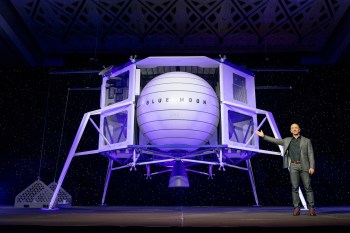
How the moon landing helped launch Silicon Valley

On July 20, 1969, the first humans set foot on the moon. The project to send them there was the brainchild of President John F. Kennedy, a goal born out of the Cold War. But its legacy can be seen in technologies found throughout the economy and private sector half a century later. In fact, the mission to put a man on the moon was deeply tied to the birth of Silicon Valley.

As the Apollo 11 traveled 238,900 miles through the vacuum of space 50 years ago, it had to chart a carefully calculated orbit.
The spacecraft had to go from a top speed of around 25,000 miles per hour, to just 2,000 miles per hour orbiting the moon. And then it had to split in two, sending down a landing module called the Eagle that would make the most gentle stop on the moon’s surface.
The only way to do these kinds of real time navigational calculations was with a computer.
“When [President] Kennedy said ‘let’s go to the moon,’ there was no computer in the world small enough and powerful enough to fly a spaceship to the moon,” said Charles Fishman, author of One Giant Leap, The Impossible Mission that Flew Us to the Moon. “The smallest computers were the size of three or four refrigerators lined up together.”
So NASA hired MIT to build the smallest, fastest computer ever created. It was about the size of a briefcase. And Fishman said this made NASA the first major customer for a brand-new invention — the computer chip.
“This Apollo flight computer turned out to be the No. 1 customer in the world for computer chips four years running, and not in a trivial way. 1961: 100%. 1964: 70%”
Those computer chips were designed in what — by the end of the Sixties — would be called Silicon Valley.
“The contract to develop those chips was important to get what later became known as Silicon Valley a jump start,” said Paul Ceruzzi, curator emeritus at the National Air and Space Museum in Washington D.C. Fairchild Semiconductors and Texas Instruments had both developed what were known as integrated circuits, or computer chips. NASA’s business was a major boost to Fairchild, whose chips Ceruzzi said are the basis of what we use today.
“Using chips in such a high profile, life-critical situation for such a brand-new technology was an enormous boost to the credibility of this technology,” said David Mindell, professor at MIT.
The navigation system using these chips was the only thing keeping Buzz Aldrin, Neil Armstrong, and Michael Collins (he stayed in orbit around the moon in the command module, Columbia while Aldrin and Armstrong descended to the surface) from being flung into the endless void of space. The chips were rigorously tested for coping with G-forces, vacuum, and radiation. If one chip out of a thousand chip batch didn’t pass any test, all one thousand were thrown out.
“Those tests, which were necessary for a spacecraft, also turned out to be very useful for what eventually became consumer products,” said Ceruzzi.
The progress in chip size and power was so rapid that by the time the Apollo 11 landed on the moon in 1969, the chips used to get it there were already outdated on Earth.
“Apollo dramatically accelerated the computer revolution,” said Fishman, “dramatically accelerated both the quality of the chips and their acceptability.”
He said it won an argument. If any business was thinking: Can we rely on these new computer things? Well, the answer was those computer things sent Apollo 11 to the moon and back.
There’s a lot happening in the world. Through it all, Marketplace is here for you.
You rely on Marketplace to break down the world’s events and tell you how it affects you in a fact-based, approachable way. We rely on your financial support to keep making that possible.
Your donation today powers the independent journalism that you rely on. For just $5/month, you can help sustain Marketplace so we can keep reporting on the things that matter to you.


















